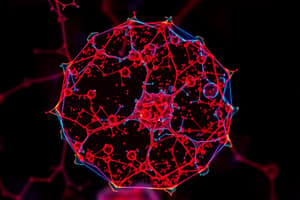Podcast
Questions and Answers
McCulloch and Till made a groundbreaking discovery in 1961 regarding a special type of cell called ______.
McCulloch and Till made a groundbreaking discovery in 1961 regarding a special type of cell called ______.
stem cell
The discovery of stem cells was described as a case study in ______.
The discovery of stem cells was described as a case study in ______.
serendipity
The researchers irradiated mice to explore the effects of nuclear ______ on cancer cells.
The researchers irradiated mice to explore the effects of nuclear ______ on cancer cells.
radiation
The colonies within each nodule developed into three types of blood cells: red blood cells, white blood cells, and ______.
The colonies within each nodule developed into three types of blood cells: red blood cells, white blood cells, and ______.
McCulloch and Till's research was published in ______ in 1963, attracting significant attention.
McCulloch and Till's research was published in ______ in 1963, attracting significant attention.
Yamanaka's work in 2006 led to the creation of induced pluripotent stem (iPS) cells and earned him a Nobel Prize for ______ or Medicine.
Yamanaka's work in 2006 led to the creation of induced pluripotent stem (iPS) cells and earned him a Nobel Prize for ______ or Medicine.
Adult stem cells are generally more ______ but have the potential to differentiate into multiple cell types.
Adult stem cells are generally more ______ but have the potential to differentiate into multiple cell types.
Stem cells play a critical role in the body's ______ processes.
Stem cells play a critical role in the body's ______ processes.
Flashcards are hidden until you start studying
Study Notes
McCulloch and Till's Discovery of Stem Cells
- Discovery in 1961: Ernest McCulloch and James Till discovered stem cells while researching the effects of radiation on bone marrow cells.
- Accidental Discovery: The discovery was serendipitous, as the researchers observed nodules on the spleens of irradiated mice.
- Colony-Forming Units (CFUs): The nodules were formed from single cells called CFUs, which could develop into various blood cell types.
- Chromosomal Markers: The researchers used irradiation to create chromosomal changes in donor cells, providing a traceable marker for identifying the origin of the nodules.
- Blood Cell Differentiation: CFUs gave rise to three types of blood cells: red blood cells, white blood cells, and platelets.
- Publication of Findings: McCulloch and Till published their findings in 1961, followed by a more prominent publication in Nature in 1963.
- Self-Renewal and Differentiation: Their research showed that bone marrow contains cells that possess both self-renewal properties and the ability to differentiate into other cell types.
- Modern Significance: The discovery of stem cells has significant implications for treating diseases and understanding the healing processes of the body.
Induced Pluripotent Stem Cells (iPS)
- Yamanaka's Work (2006): Shinya Yamanaka reprogrammed mature cells into stem cells using specific genes.
- iPS Cells: This groundbreaking research led to the creation of induced pluripotent stem (iPS) cells, which have the potential to differentiate into any cell type.
- Nobel Prize: Yamanaka was awarded the Nobel Prize in Physiology or Medicine for his work.
General Stem Cell Information
- Stem Cell Presence: Stem cells exist throughout a person's lifespan, from embryonic development to adulthood.
- Embryonic Stem Cells: Embryonic stem cells are pluripotent, meaning they can differentiate into any cell type.
- Adult Stem Cells: Adult stem cells are typically more specialized, but can differentiate into multiple cell types.
- Flexibility of Adult Stem Cells: Recent research suggests that adult stem cells might be more flexible than previously thought.
Studying That Suits You
Use AI to generate personalized quizzes and flashcards to suit your learning preferences.




